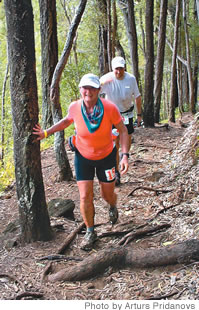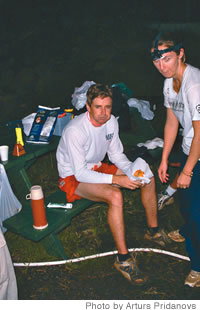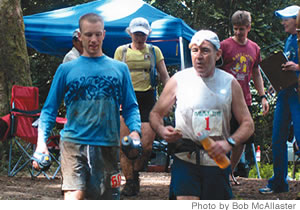100 Miles of Hurt
So here’s a fun way to spend the Martin Luther King holiday weekend - run 100 miles up and down Tantalus trails. It’s fun, say past participants, except for the pain. One minute, ultra-runners Don Fallis and Bob McAllaster are telling me how fun the HURT 100-mile run is.

By .(JavaScript must be enabled to view this email address)
E-mail this story | Print this page | Archive | RSS

|
ty tough, when that’s 100-200 feet.”
McAllaster adds, “You go through a lot of ups and downs physically and mentally, and it’s easy to get stuck in one of those downward spirals where you’re, like, my knees are hurting and my stomach isn’t feeling good. If you’re not familiar with being in that situation, then it’s hard to get back out of that. And pretty soon you quit because it’s so much easier than going back out there.”
The finishing rate for the HURT 100 is only about 25 percent, which means three of every four runners will not make it to the finish line. But when the race directors planned the race, they decided to offer a 100K (62 miles) option so that runners who decide not to go on and complete the 100 miles can still get some well-deserved recognition.
Fallis completed the 100K option in his three attempts. And Carlsson finished the 100K option during his last attempt at the 100-mile run.
“I actually did this race two years ago without training very much,” says Carlsson, a running specialist and weekly running club coordinator at Niketown. “Basically some of the guys in the HURT club asked me to join them on a loop, which is 20 miles, and that was fun. So they suggested that I run the 100-mile run, so I decided that, hey, I ran one loop I can probably do a couple more. So I ran the Honolulu Marathon in December and then trained for just five weeks with only three long runs. And I really, really struggled through the race to finish the last 15 miles. It’s so difficult. When I finished that race I said I would never do this again - and here I am again. I think I have forgotten the pain. But I have trained a lot harder.”

|
This time around, Carlsson also is much more prepared. He has a team that has been helping him train and will be there on race day to assist him with everything from his nutrition to shoes and socks. He also has 10 pacers who will help keep him going through the final 60 miles.
“In trail running, you need to come a little better prepared,” says Carlsson, who adds that in training for this run he has been averaging about 100 miles per week. “With road running you can throw on a pair of shoes, there’s water fountains along the way. Trail running just takes so long to cover the distance. You need more sturdy shoes, and carrying water with you is essential.”
Carlsson also is entering this year’s race with an added boost, having decided to run for three charities: Angel Hair Foundation, Bryan Clay Foundation and the Susan G. Komen Foundation.
The charities, he says, brings purpose to his run and will provide added motivation.
“I am going into this race pretty confident,“says Carlsson, whose training regime also has included sleep deprivation. “I’m much better prepared. I know I’ll finish the 100K, but it’s the next 20 miles that I’ve never done, that I don’t know.”
As Carlsson explains, finishing a 100-mile run isn’t every long-distance runner’s goal. “If you’re talking long-distance runners, most people’s goals are to finish a marathon. Then there are a few select people who go beyond that.”
It is those people that HURT helps support, particularly those who enjoy trail running.

|
Fallis, who has been with the group for the past 10 years, says, “HURT here locally is a close, family group. We all work together to help each other on the trails and so we’re really close. It’s not competitive like marathons and other races.”
Which may be why the event is referred to as a run instead of a race. While there are some experienced ultra runners who are running for time, most are just running to finish - including Carlsson.
“If everything goes according to plan I’ll finish in 35 hours - so my goal is basically just to finish,” says Carlsson.“Right now I’m saying this is going to be my one and only 100-mile run. I know my body tends to break down after about 50 to 60 miles, and so I’m thinking that just may be my physical limit.”
The interest in ultra running has become quite clear, as Fallis explains that this year all the spaces for the HURT 100 were taken in just one day.
Everyone interviewed agreed that it isn’t for the money because there isn’t any, and it isn’t for the fame because besides a finisher’s T-shirt, there’s very little glory in long-distance running. It’s for what they call personal reflection, and it’s the lessons learned on the trail that are directly translated into everyday life.
As McAllaster explains, “One thing that I live by is ‘Don’t make any big decisions on the way up’ - in running and in life. Running uphill, all kinds of things go through your mind and you may want to quit, but that’s not the decision that you should be making. So when things are hard in life, just wait until things start moving smoothly (like when you start running downhill) before making any important decisions.”
Fallis adds, “When challenges come up in life, you look at it and think, hey, I’ve run 100 miles, how hard can this be?”
For those up to the challenge, HURT is always welcoming new members. Its trail series, which is a gradual training for the 100-mile run, begins in March or April with shorter runs, and by Labor Day the serious training kicks in with a 50K run.
For more information on HURT, this year’s finishers or the trail series, visit http://www.hurthawaii.com or http://www.hurt100trailrace.com.
Page 2 of 2 pages for this story < 1 2
E-mail this story | Print this page | Comments (0) | Archive | RSS
Most Recent Comment(s):








